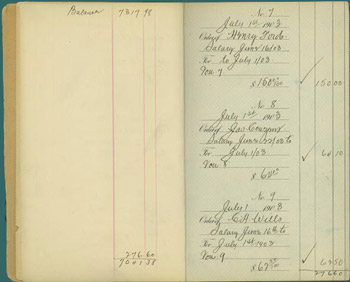 |
|
| |
|||||||
|
|||||||
|
|||||||
MORE: Ford Motor Company's First Check Book |
||||
In 1899 Henry Ford left the only steady job he had ever had as chief engineer of the Edison Electric Illuminating Company in Detroit to start an automobile company. By 1903 that first company had failed, and he had quit a second company in a dispute with his financial backers. Despite all the evidence to the contrary, Ford convinced a new group of investors that there was money to be made manufacturing automobiles designed by Henry Ford. On June 16, 1903 those investors filed articles of incorporation for the Ford Motor Company. On June 22 one of the investors, James Couzens, began keeping the checkbook. The layout of the book is a bit unfamiliar to modern check writers. On the right hand side of the book were the checks and their stubs, three to a page. Today, of course, the checks are gone and only the stubs remain. The left hand facing page was blank, and here Couzens recorded deposits and kept a running balance. The new company had a total of twelve investors, and they were supposed to put up a total of $100,000. Henry Ford and his principal partner Alexander Malcomson put up no cash, but each got credit for $25,500 based on plans, machinery, patents, and other work they had already done. Of the other ten investors, only a few actually made their full investment in cash. Some put up part of the money and signed a note, or promise, to pay the rest. Others simply signed a note. Thus it was that the new company began with only $19,500 in its checking account.
Some of the investors who risked their money
on two-time loser Ford were better rewarded than others. A few sold
out early and made thousands. Others hung on longer and made millions.
Couzens, who had the nerve-wracking job of watching the fledgling company’s
daily cash flow, sold his stock to Henry Ford in 1919 for $29,308,857.90.
His sister Rosetta, who had loaned him $100 (half her life savings)
to help make his original investment, received $262,036.67.
|
||||
|
|
| Copyright © The Henry Ford ~ http://www.TheHenryFord.org |



